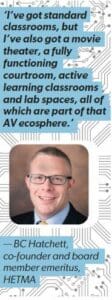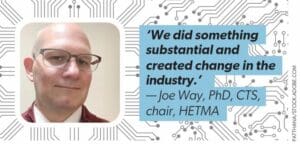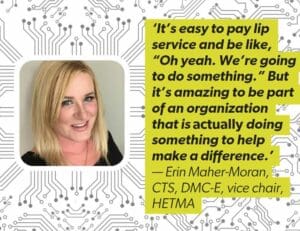If you’ve attended commercial AV trade events in the last, say, five years, you’ve likely noticed a not-so-subtle shift while walking the show floor. Whereas, in the past, it was often hard for higher-education technology managers and other so-called “end users” to gain exhibitors’ attention, we’ve lately seen a collective awakening to the fact that individuals like these are a critical part of the conversation. Increasingly, vendors are leaning on technology managers for guidance on how to optimize their offerings; meanwhile, many integrators have come to embrace the opportunity to have fulsome design-related discussions with those whose knowledge and certifications often equals their own.
No single organization can take credit for this profound transformation, but there’s no doubt that the Higher Education Technology Managers Alliance (HETMA) has been leading the charge. This month, Commercial Integrator speaks to several members of its brain trust to understand how the organization developed, its core values, its ongoing initiatives, recently formed partnerships and some exciting developments on the horizon. Our interviewees include Joe Way, PhD, CTS, chair; Erin Maher-Moran, CTS, DMC-E, vice chair; Annie Foster, secretary; BC Hatchett, co-founder and board member emeritus; and Donovan Monday, chair of the HETMA Approved program.
How HETMA Arose
Reflecting on HETMA’s creation in 2019, co-founders Way and Hatchett recall that the idea originated during a manufacturer event, where they were providing product feedback. Other higher-education professionals were also on hand, and they found themselves commiserating about their campus environments, common struggles and shared experiences. “It was an incubator for what HETMA would become,” Hatchett says, “which is really a platform for higher ed in the manufacturing world.” Beyond that, though, HETMA is truly an advocacy group, representing the interests of higher-education technology managers and, in so doing, the interests of the instructors and students they serve.
Why does higher education, in particular, need an organization like HETMA to advocate for its interests? Way points to the fact that the higher-ed vertical spends roughly $30 billion on technology annually, a figure that doesn’t include spending for live events, stadium spaces, etc. He continues, “As an organization, we said, ‘We need a voice to represent that $30 billion.’” What a voice HETMA has created for itself! As of a mid-January interview, the organization had more than 1,000 members, representing about 300 schools. If you say the average higher-education institution has about 15,000 students and then do the math, HETMA is directly affecting something like 4.5 million students’ education experience.
In only four years, HETMA has already achieved a staggering level of influence. And that helps explain the transformation we discussed at the outset. Hatchett recalls past InfoComm shows when large integration groups would go from booth to booth, and everyone’s attention would immediately turn to them. “Now, we’re getting just as much — if not more — attention from the booth staff and from representatives,” Hatchett attests, underscoring that the pendulum has swung. Increasingly, vendors are coming to recognize higher-ed technology managers’ buying power, as well as their extensive knowledge of how these systems work in learning environments. Way also notes the frequency with which he sees AVIXA trainers tweeting about HETMA members being in their CTS classes. “While we are end users,” he says, “we are also moving to certified professionals. And that shift is already happening.”
Inside Higher Education
 The experience HETMA members offer is particularly indispensable because higher education is a unique vertical, quite different from all others. Maher-Moran pinpoints one signature of higher ed: extremely tight timelines. “Things are so tightly scheduled that we don’t have time to take hours to troubleshoot,” she remarks. “We have to be able to get in, make it work and get back out in a matter of 10 minutes between classes.” Compounding the challenge, Hatchett says, is the diversity of environments found on campuses. “I’ve got standard classrooms,” he begins, “but I’ve also got a movie theater, a fully functioning courtroom, active learning classrooms and lab spaces, all of which are part of that AV ecosphere.”
The experience HETMA members offer is particularly indispensable because higher education is a unique vertical, quite different from all others. Maher-Moran pinpoints one signature of higher ed: extremely tight timelines. “Things are so tightly scheduled that we don’t have time to take hours to troubleshoot,” she remarks. “We have to be able to get in, make it work and get back out in a matter of 10 minutes between classes.” Compounding the challenge, Hatchett says, is the diversity of environments found on campuses. “I’ve got standard classrooms,” he begins, “but I’ve also got a movie theater, a fully functioning courtroom, active learning classrooms and lab spaces, all of which are part of that AV ecosphere.”
Another way that diversity manifests is in how the institution deploys, manages and services its technology. For example, does it have an in-house installation team or utilize an outside integrator? Does it rely on an internal support department, or does it turn to a remote management system? Those questions aren’t just academic (no pun intended); rather, they get to the heart of system effectiveness and product suitability. “Each product might be good, but it might only have a specific use case,” Way observes. “You can have an incredible microphone system, but, if you don’t have an in-house integration team to put that together, it might not be the solution for you.” And given that higher-ed technology managers are typically buying and deploying technology at scale — not one unit but, rather, 200 units — it’s critical that they’re making the right decisions.
These realities inspired HETMA to initiate one of its most ambitious undertakings: the HETMA Approved program. In short, the program aims to leverage HETMA members’ penetration into higher-education environments of all sizes and scales to determine whether products work in those learning-centered technology ecosystems. Next, we’ll dive into all the details.
The HETMA Approved Program
According to Monday, chair of the HETMA Approved program, the initiative was always intended to have a big impact — namely, to give members great information and, as a result, to improve higher-ed outcomes across the board. “The process is pretty straightforward,” he explains. “A company signs up, and they send us a product or multiple products,” which HETMA then passes along to evaluator members. The heterogeneity of HETMA’s membership — large, medium, small and community-level higher-learning institutions — makes the program even more robust. “We try to spread out these products among them,” Monday states. “Because a large university might use a product differently than a small university might. So, we want to see how those products are being used regardless of the size of the university, or even the technical ability of the person.”
Related: Joe Way, PhD, CTS on Leading Factors Shaping EdTech Today
Diving deeper, HETMA evaluators put the products into real-world environments and evaluate whether they fit into the workflow. Judging criteria include whether products do what manufacturers say they do, whether they meet HETMA’s quality benchmarks and whether they’re a fit for higher ed (as opposed to other verticals). What’s remarkable is that this rigorous process — being HETMA Approved is no rubber stamp! — is often done in 30 days. If there’s a delay in any part of it, the timeline can be extended to 60 days. “We have products coming in, seeking HETMA approval, from every major manufacturer out there right now,” Hatchett says with pride. And, in fact, at the time of our mid-January interview, five manufacturers (Huddly, Bose, Elgato, Epiphan and Panasonic) had already attained HETMA Approved status across 12 products. Meanwhile, another five manufacturers and 13 products were in the middle of being evaluated.
From Way’s perspective, the HETMA Approved program’s greatest virtue is that it will embolden higher-ed technology managers when they ask for hundreds of thousands of dollars to invest in technology, because they’ll no longer fear they’re making a wrong decision. Eventually, being HETMA Approved might become table stakes to get your product spec’d at scale at some of these institutions. It’s unsurprising, then, that Monday adds, “The manufacturers have been fantastic about it. Our manufacturer list is growing every single day.”
Values-Driven Organization
HETMA is a values-driven organization, and its activities flow naturally from the ethical principles to which it adheres. One of those values is egalitarianism; indeed, from the start, Way wanted to ensure that everyone was treated the same…that everyone had the same platform. Monday acknowledges that, without HETMA, technology managers from tiny schools would never have the opportunity to shape the industry conversation. “Those of us in rural schools and rural areas in the world didn’t have an outlet to talk these things out and be part of something bigger,” he continues. “HETMA’s really allowed that to happen.” Hatchett concedes that our industry can be cliquish and certification obsessed. But that makes HETMA’s approach — where no one is left behind — even more refreshing. “Everybody has a voice in this,” he declares.
HETMA centers its activities on the idea of helping…of making a difference. One action item for the organization, therefore, has been to drive diversity and inclusion within the technology community. With emotion evident in his voice, Way laments that the commercial AV industry has actually sunk, post-pandemic, to being 9% women. (Previously, our industry had had 14% female representation.) “I was shocked to hear that our industry has actually gone backwards at a time we’re all so focused on it,” he continues, citing various industry advocacy groups supporting DEI efforts. If anything, though, those trouble trends have steeled HETMA’s spine to effect change. And the organization clearly knows how to do it: After all, during the same period, HETMA substantially grew its female demographic not only as members but also in running the organization and leading initiatives. One of HETMA’s proudest achievements, which we’ll turn to next, is creating the Prism Scholarship, which we turn to next.
The Prism Scholarship
 HETMA, working in association with AVIXA, announced the Prism Scholarship at InfoComm 2021 with the vision of supporting underrepresented communities’ growth within the U.S. higher-education technology workforce. HETMA seeks to encourage women, LGBTQIA+, Black, Latino, Asian, Indigenous and disabled persons to become active leaders and role models for technology managers in the higher-education space. The goal each year is to offer 10 scholarships, whose recipients receive resources that, ultimately, will help them pass their CTS exam. According to Foster, those resources include one year of access to AVIXA training modules, complimentary exam access at testing center or at InfoComm, and a HETMA-sponsored trip to InfoComm. “We wanted to really bring them into the network and let them see the experience of going to InfoComm,” she says. “Getting exposed to all the different vendors and all the people in the community.” Just as importantly, scholarship recipients are partnered with a CTS-certified HETMA member to guide them through their study process.
HETMA, working in association with AVIXA, announced the Prism Scholarship at InfoComm 2021 with the vision of supporting underrepresented communities’ growth within the U.S. higher-education technology workforce. HETMA seeks to encourage women, LGBTQIA+, Black, Latino, Asian, Indigenous and disabled persons to become active leaders and role models for technology managers in the higher-education space. The goal each year is to offer 10 scholarships, whose recipients receive resources that, ultimately, will help them pass their CTS exam. According to Foster, those resources include one year of access to AVIXA training modules, complimentary exam access at testing center or at InfoComm, and a HETMA-sponsored trip to InfoComm. “We wanted to really bring them into the network and let them see the experience of going to InfoComm,” she says. “Getting exposed to all the different vendors and all the people in the community.” Just as importantly, scholarship recipients are partnered with a CTS-certified HETMA member to guide them through their study process.
The Prism Scholarship is open to full-time staff members at higher-education institutions who are not also employed by an integrator. Moreover, candidates must express a need for support in furthering their education. Finally, candidates must identify how they fit into an underrepresented category, although scholarship organizers don’t want to impose rigid requirements on that metric. “We’re asking them to express why they think they belong to an underrepresented category and just to explain it to us,” Foster says. Applicants must answer essay-style questions about why they deserve the scholarship, how they plan to achieve the goal of becoming CTS certified, and how they fit into an underrepresented group.
Creating something like Prism was personal to Way, who recalls, in the early days of HETMA, having been “called out” online for putting together a steering committee entirely composed of middle-aged white guys. “It was a blind spot, and we were called out for it,” he acknowledges. “At that point, it really hit me: We need to make change.” But it wasn’t merely about transforming HETMA’s own composition; it was about transforming the community broadly. “We did something substantial and created change in the industry,” Way says with evident pride.
Making a Difference
For HETMA leadership, there is no greater acid test than whether an initiative really, truly would make a difference in people’s lives. Speaking of Prism, Way recalls, “The very first conversation that I had, talking to Joé Lloyd, was, ‘I want to do this, but it has to be substantial. It can’t just be a press release. We need to do something that can actually take someone’s career and make it better.’” Maher-Moran seconds that vision of a purpose-driven organization. “It’s easy to pay lip service and be like, ‘Oh yeah. We’re going to do something,’” she says. “But it’s amazing to be part of an organization that is actually doing something to help make a difference.” And DEI, while absolutely critical, isn’t the only advocacy area that HETMA touches.
In late 2022, HETMA announced a partnership with Sustainability in AV (SAVe) to expand sustainability initiatives through higher-education institutions across the U.S. Maher-Moran says that, during an initial meeting with Christina DeBono, founder and president of SAVe, HETMA for the first time really dug into the 2030 Sustainable Development Goals (SDGs) and was immediately enthusiastic. “When we looked at each of the goals, there were little things in there that just aligned so well with higher ed,” Maher-Moran adds. HETMA knew it could increase public familiarity with SDGs and move forward via established programs. One such program, called SAVe a Second Life, encourages the repair, reuse, repurposing, recycling and proper disposal of AV equipment. Immediately, HETMA saw the benefit in helping smaller schools and organizations, which don’t have large budgets, get access to technology they’d otherwise never have. “It’s giving those pieces of equipment a second life, instead of having them sitting in a landfill,” Maher-Moran explains.
Related: SAVe Joins Forces with HETMA to Support Sustainability
SAVe certification training is a powerful method of advancing the goals of increasing the visibility of the SDGs and, in so doing, protecting our planet. Thus, Way, the director of learning environments at the University of Southern California (USC), seized the opportunity to host the first higher-education SAVe certification training session back in November. Indeed, USC is the very first university certified by SAVe, although it certainly won’t be the last. “We hope to increase that number and get a lot of our member schools certified, so that we can help that little bit more with sustainability efforts,” Maher-Moran says. Way sets forth a vision he dubs “train the trainer,” where he hopes SAVe can certify learning institutions’ own trainers to then go out and certify other schools. Much as with technology, Way is thinking about how to scale this. “You take this across a vertical…think how much impact we can have,” he says, a smile coming across his face.
Building Community
 At its heart, HETMA is a community of technology professionals, and that tight-knittedness extends to the digital world. Recently, the organization opened up its online community to corporate partners, thus broadening opportunities for members to dialogue with stakeholders to create exceptional education experiences. Within the larger overall ecosystem, there are roughly 30 subcommunities, including forums for tech talk, troubleshooting, job openings and making regional connections. Although segmented-off areas remain for higher-ed professionals only, they sit in parallel with open areas where vendors can freely participate. “This is just on fire,” Way enthuses, describing the platform for having real conversations in an enclosed community as being like “Facebook on steroids.” He adds, “It’s just a great way to interact with one another.”
At its heart, HETMA is a community of technology professionals, and that tight-knittedness extends to the digital world. Recently, the organization opened up its online community to corporate partners, thus broadening opportunities for members to dialogue with stakeholders to create exceptional education experiences. Within the larger overall ecosystem, there are roughly 30 subcommunities, including forums for tech talk, troubleshooting, job openings and making regional connections. Although segmented-off areas remain for higher-ed professionals only, they sit in parallel with open areas where vendors can freely participate. “This is just on fire,” Way enthuses, describing the platform for having real conversations in an enclosed community as being like “Facebook on steroids.” He adds, “It’s just a great way to interact with one another.”
What’s more, this year, HETMA will launch lunch-and-learn sessions through the community, as well as other community-based education opportunities. Maher-Moran counterposes this, in a very positive way, to “traditional” integrator and vendor interaction, which, basically, is a few minutes at trade shows and then follow-up email blasts. “We’re trying to warm it up a little bit,” she explains. “Be able to have lunch-and-learns, and then have conversations happen right there.” Clearly, that recipe is working; indeed, during our mid-January interview, the community had doubled in size in 17 days. Whereas, formerly, HETMA, whose membership numbers 1,000-plus, had had about 400 members active in the community, Way says that has now likely doubled. As you read these words, these numbers will likely be vastly larger.
Commercial Integrator Expo
With Commercial Integrator’s corporate parent, Emerald, launching Commercial Integrator Expo this year, HETMA saw a fresh opportunity to serve its members and facilitate better education outcomes. HETMA will serve as an official education partner, which Way describes as, “Taking education from our backend and bringing that out into the world.” Hatchett is running point on that initiative, and he describes the first year as an ideal opportunity to find common ground between Commercial Integrator Expo and the HETMA community.
Related: Commercial Integrator Expo Unites with HETMA
Most excitingly, at the HETMA booth on the show floor, the organization will create a HETMA Approved classroom, which will be populated with HETMA Approved program products. “I really think that’s going to be a first-of-its-kind booth,” Hatchett says, calling it a full ecosystem that will illustrate how things work together. “We’ll really give all these folks a glimpse into what we’re looking for in our environment…what we’re looking for their products to do for us,” he adds. Pairing the show-floor element with HETMA-run education sessions, Commercial Integrator Expo attendees will get a real feel for what higher-education environments want, demand and need.
And that kind of information is essential, Hatchett says, because integrators and vendors aren’t necessarily in fully functioning higher-education spaces every day to understand exactly what HETMA members need. “Let us tell you what works,” he says. “Let us tell you what doesn’t work. Then, let’s work together to help make you money, essentially.”
Nothing to Fear
Although some integrators may still wish technology managers didn’t have a seat at the table, it seems unlikely that reality will ever revert to the old ways. “Before, we were completely dependent on the integrator to tell us what we needed, what we were going to do, and how this was going to get installed,” Monday recalls. “We were completely reliant on an integrator for that.” With the rise of organizations like HETMA, and technology managers coming to be recognized as certified professionals, that has changed. But it’s not about displacing integrators or eliminating their utility; rather, it’s about more robust collaboration to deliver outstanding outcomes. “By having those more educated conversations with integrators and with manufacturers, we’re able to shape our rooms and our environments a lot better,” Monday adds. “More to what we need them to be.”
Way seconds that sentiment, declaring that, with HETMA’s rise, his relationship with USC’s partner integrators has actually improved. “Now, we can have different conversations,” he explains. “Now, we can sit down and have solutions conversations.” By demonstrating their equal status in both ability and fundamental understanding of craft, HETMA members are perceived not as a “threat” to integrators but, rather, as trusted collaborators.
Make no mistake: Many HETMA members understand some integrators’ skittishness about their new level of power and influence. After all, HETMA has members who have worked both on the integrator side and in higher ed. “We come at it from a very diverse perspective and with a very deep knowledge base,” Hatchett says. But there’s nothing to fear from having stakeholders at the table who are absolutely committed to ensuring instructors, students and campus visitors have the most incredible experiences that technology can create; rather, it’s an opportunity to leverage complementary skill sets and overlapping areas of expertise.
“Is it what you would have seen five years ago?” Way asks. “No. I actually think it’s much better now.”










